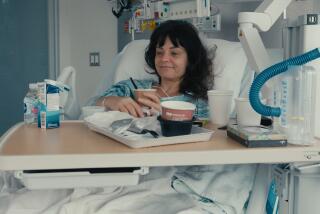This sibling donor story is strictly fiction
- Share via
“My Sister’s Keeper”
New Line Cinema
In theaters (released June 26)
The premise
Three-year-old Kate Fitzgerald is diagnosed with promyelocytic leukemia after her mother, Sara Fitzgerald (Cameron Diaz), spots bruises on her back. Despite chemotherapy, her leukemia continues to recur. She requires a bone marrow transplant, but her parents and her brother are not compatible (her doctor says the chance of a match is only 1 in 200).
The parents choose to have another child, using in vitro fertilization and pre-implantation genetics to ensure that the offspring, Anna (Abigail Breslin), is a 100% match. Anna becomes her sister’s perpetual donor over the next 11 years: donating umbilical cord blood, whole blood, bone marrow (twice), blood stem cells (twice), white blood cells (lymphocytes and granulocytes) and growth hormone -- all without her permission.
At age 11, Anna is asked to donate a kidney when Kate (Sofia Vassilieva) is close to death and going into renal failure, but neither sister wants to go ahead with it. Anna consults an attorney, who fights for her “medical emancipation.”
The medical questions
How common is promyelocytic leukemia and what is the prognosis in young children? What role does donation of blood products play? Could pre-implantation genetics be used to create a compatible sibling donor? Would a patient such as Kate receive growth hormone? Could an 11-year-old refuse to donate a kidney, or would she have to be “medically emancipated” first? Would a patient with recurrent acute leukemia be considered as a recipient for such a transplant?
The reality
Acute promyelocytic leukemia, in which immature granulocyte precursor cells become malignant, is very rare, as the film suggests, representing just 4% to 8% of all cases of acute myelogenous leukemia, or cancer of the blood and bone marrow.
Although the disease can be deadly, the movie is completely unrealistic in portraying it as so difficult to treat, says Dr. William Carroll, director of the New York University Cancer Institute and the Pediatric Hematology Oncology program at NYU Langone Medical Center. Retinoic acid and arsenic are standard treatments and lead to cures or prolonged remissions in more than 75% of patients. “Bone marrow transplant in this type of childhood leukemia is reserved for the rare patients that relapse,” adds Dr. Christopher Dvorak, assistant professor of pediatric blood and marrow transplantation at UC San Francisco and lead author of a landmark study on the topic.
Dvorak says that the chance of a sibling bone marrow match is actually 25%, not 1 in 200 as the film portrays. He also says that it is completely implausible that a patient would get cord blood and then two bone marrow transplants from the same donor because the first failed transplant demonstrates an inability to control disease with blood products from this particular source. “All transplant physicians would have switched donors by this point,” he says. Granulocyte and lymphocyte transfusions can be used to control infection after chemotherapy or a transplant, but there is no reason whatsoever to obtain them from a sibling donor. They don’t need to be matched and can be obtained from an adult volunteer.
Pre-implantation genetic diagnosis, the genetic screening of embryos before placement in the uterus, can be used to select an embryo that will be a suitable donor, as the film suggests.
The portrayal of growth hormone donation is pure science fiction, Dvorak says. “It isn’t possible or necessary to obtain sufficient quantities from a living donor,” he says. “Kate’s doctor would just get the hormone from the pharmacy.”
It is against the law in the state of California to harvest a solid organ from a minor. In states where the practice is legal, “no credible transplant center would let a kid donate a kidney based on the parents’ consent alone,” says Dr. Lloyd Ratner, director of renal and pancreatic transplantation at Columbia University College of Physicians and Surgeons in New York.
A kidney transplant would be considered in a patient with leukemia only if she or he had been successfully treated and there was no evidence of recurrence, Ratner says. It is also likely that one of the parents would be a compatible kidney donor because HLA-identical donors such as Anna are not strictly necessary for organ transplants the way they are for bone marrow.
The advantage of an identical organ donor, however, is that this takes away the need for treatment with immunosuppressive drugs.
The bottom line
“My Sister’s Keeper” is wildly inaccurate on many crucial medical facts.
--
Siegel is an associate professor of medicine at New York University’s School of Medicine.
More to Read
Only good movies
Get the Indie Focus newsletter, Mark Olsen's weekly guide to the world of cinema.
You may occasionally receive promotional content from the Los Angeles Times.






